A Comprehensive Guide to Building Your Own Kite
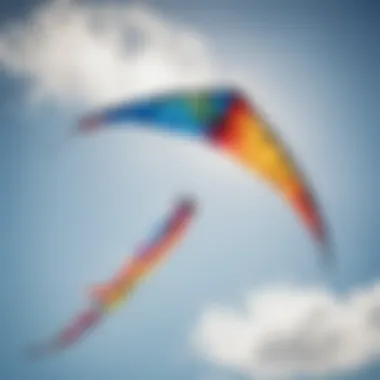
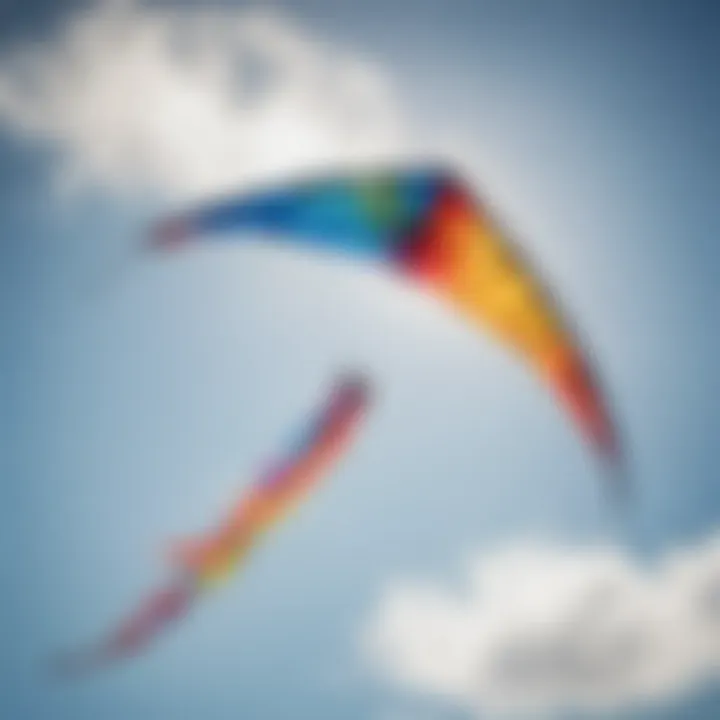
Intro
Building a kite isn't just a hobby; it's an experience that intertwines creativity, science, and hands-on craftsmanship. For those who appreciate the thrill of the wind and wave, engaging in kite construction offers a unique avenue to elevate their kitesurfing escapades. The tactile sensation of creating something that dances against the azure sky turns a simple day on the water into a personalized adventure.
In this guide, we will traverse the intricate pathways of kite building, exploring the essential materials, the mechanical principles of aerodynamics, and the design techniques that draw on both art and science. This journey is not merely technical; it is an invitation to infuse your personality into the kites that propel you across the water. Whether it's your first kite or you're looking to refine your techniques, this article will set the stage for an exhilarating deep dive into the world of kite crafting.
Gear Essentials
Before we can build our kite, it’s essential to understand the right gear and materials to ensure both functionality and performance. With the right tools at your disposal, everything else becomes a kite-flying breeze.
Top Picks for Watersports Equipment
The choice of materials can make or break your kite-building endeavor. Here’s a rundown of must-have items:
- Tailwind Ripstop Fabric: Lightweight yet durable, ripstop fabric can withstand the winds and the occasional mishap.
- Carbon Fiber Sticks: These maintain a good strength-to-weight ratio, ensuring your kite doesn’t topple over while soaring.
- String: Quality kite line is critical. Look for high tensile strength to ensure longevity.
- Reinforcement Tape: Extra strength where it matters—corners and stress points, to prevent tearing when the weather gets tricky.
If you feel like experimenting, consider using biodegradable components. It’s a niche, but it’s gaining traction with eco-conscious builders who also love watersports.
Maintenance and Care Tips for Gear
Once you have your kite built, taking care of it is equally as important. Here are simple yet effective care tips:
- Rinse after Use: Always rinse your kite with fresh water after a session at the beach to prevent salt build-up, which can degrade materials.
- Inspect Regularly: Check for any signs of wear and tear. Noticing small damages early on can save you from larger disappointments.
- Store Properly: Keep your kite in a cool, dry place away from direct sunlight. This will extend its lifespan significantly.
“A well-maintained kite is like a loyal friend; it will always have your back when the winds are right.”
By investing time into the care of your equipment, you'll enjoy a seamless experience on water, making it all the more thrilling to test the kites you create.
Understanding Kite Design
When it comes to kite building, understanding design principles is crucial. It forms the foundation of how a kite operates once it meets the wind. Knowledge of kite design not only enhances performance but also allows builders to create kites that suit their specific needs, particularly in relation to kitesurfing.
Without a solid grasp of design, builders might find themselves lost in the sea of materials and construction techniques available. Each kite has unique characteristics formed by its shape and structure, which ultimately affect its flying capabilities.
Types of Kites
- Different styles of kites serve varied purposes. Selection among them can affect everything from maneuverability to stability. Here’s a breakdown of major types:
Stunt Kites
Stunt kites are pivotal when talking about agility and tricks. What sets stunt kites apart is their dual-line control, allowing for sharp turns and impressive aerial maneuvers. This is a favored choice for those looking to perform stunts, making them a staple in kite flying circles. One unique feature of stunt kites is their remarkable responsiveness to pilot input. Advantages include the ability to perform tricks, but they do require practice and skill, which may be daunting for newcomers.
Single-Line Kites
The classic single-line kite is defined by its straightforward design. As the name suggests, these kites operate with a single line, making them easier to handle for beginners. Their simplicity is a key characteristic, and the ease of launching and flying does lend to a more relaxed kite-flying experience. A notable advantage is that they can float gently in the sky, providing a beautiful sight; however, they lack the agility needed for tricky maneuvers.
Box Kites
Box kites, with their unique cubic structure, present a distinctive fly. Their design allows for greater wind resistance and stability. This type of kite stands out due to its ability to catch wind from multiple angles, making it viable even in less than ideal weather conditions. Box kites are popular for those who enjoy a steady flight, but they can sometimes be challenging to launch due to their weight and bulkiness.
Delta Kites
Delta kites have a triangular shape that contributes to excellent lift and stability. These kites are often favored for their balance and ease of flight—traits essential for those looking to cruise. They perform well in various wind conditions, providing flexibility that some other designs lack. One significant advantage is that the delta kite can remain airborne even in relatively light winds, though they may not be as agile as stunt kites.
Principles of Aerodynamics
The foundations of kite building lie heavily within the principles of aerodynamics. Crafting a kite is no mere craft; it's about understanding the forces at play when chocolate chip cookies fall into your hands oh wait, sorry, that's the metaphorical triumph! Here's where understanding specific aerodynamic principles comes into the fray:
Lift and Drag
Lift is the force that raises the kite into the sky, while drag is the resistance it faces due to air flow. This pairing plays a vital role in determining how well a kite performs. A properly designed kite will maximize lift while minimizing drag. By fine-tuning these aspects, builders can ensure their kites reach new heights—literally.
Stability and Control
Stability is paramount in kite design; without it, a kite can become erratic in flight. Stability translates to the ability of the kite to maintain its position in the air despite gusty winds. Understanding and controlling the balance between stability and the ability to maneuver is essential for achieving a pleasurable flying experience, especially for kitesurfers looking to harness the wind.
Wind Conditions
Wind conditions are often the unsung hero in kite performance. Knowing how a particular kite design reacts to various winds can drastically alter the flying experience. For example, a lightweight kite may excel in gentle breezes yet falter in strong winds. Consideration of these conditions ensures that your kite flight is not only enjoyable but also safe.
"Knowledge is power, but knowing how to utilize that power takes it to another level."
The understanding of these various types of kites, combined with aerodynamics, can guide new builders toward making informed decisions. Equipping oneself with this knowledge can lead to a rewarding and enjoyable kite-building experience.
Materials Needed
When embarking on the journey of kite building, the importance of selecting suitable materials cannot be overstated. The right materials significantly influence the kite's performance, durability, and aesthetic appeal. In this section, we'll dig into the essential components, examining frame materials, sail fabrics, and the strings and connectors that keep everything together. Whether you're a seasoned builder or just starting out, understanding these materials lays a solid groundwork for your kite-making endeavors.
Frame Materials
Wood
Wood has a nostalgic charm that resonates with many kite enthusiasts. It's often the go-to choice for traditional kite builders due to its availability and ease of use. A key characteristic of wood is its flexibility, which allows it to bend slightly in the wind without breaking, providing resilience in challenging conditions. Moreover, wood gives a kite a classic look that speaks to craftsmanship and care.
However, it's worth noting that wood can be heavier than other materials. This weight can impact the kite's ability to soar at greater altitudes, particularly in light winds. Additionally, wood requires regular maintenance to prevent warping from moisture exposure. A balance of beauty and practicality, it serves as a reliable choice for those who appreciate old-school kite crafting.
Fiberglass
Fiberglass represents a leap forward in kite construction materials. Light yet incredibly strong, it offers a remarkable combination of durability and ease of handling. This material can withstand the rigors of flight, including strong winds and rapid changes in direction, making it especially suited for stunt kites.
The unique feature of fiberglass is its resistance to breaking under stress, which is a definitive advantage when you push your kite to its limits. However, one must also consider that fiberglass can be more expensive than wood and might require the use of specialized tools for cutting and shaping. As such, while it does come with a price tag, the performance benefits it provides are often worth the investment.
Carbon Fiber
If you're in pursuit of a high-performance kite, carbon fiber stands at the pinnacle of kite frame materials. Renowned for being incredibly lightweight, carbon fiber allows for the creation of sleek and agile kites that dance gracefully in the sky.
Its defining characteristic is the unmatched strength-to-weight ratio, meaning you can achieve structural integrity with minimal material. This lightness translates to a kite that can easily lift off with less wind. However, carbon fiber is on the pricier side and can be tricky to work with for novice builders. If you’re serious about kite building and want to achieve phenomenal flight performance, carbon fiber's superior characteristics might be the way to go, just be prepared to handle the learning curve and investment.
Sail Fabrics
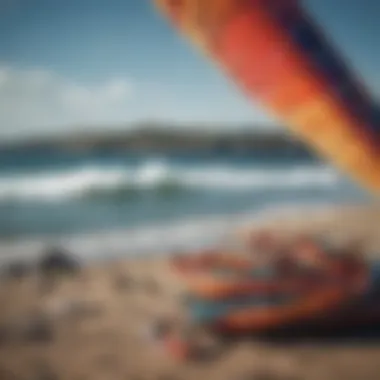
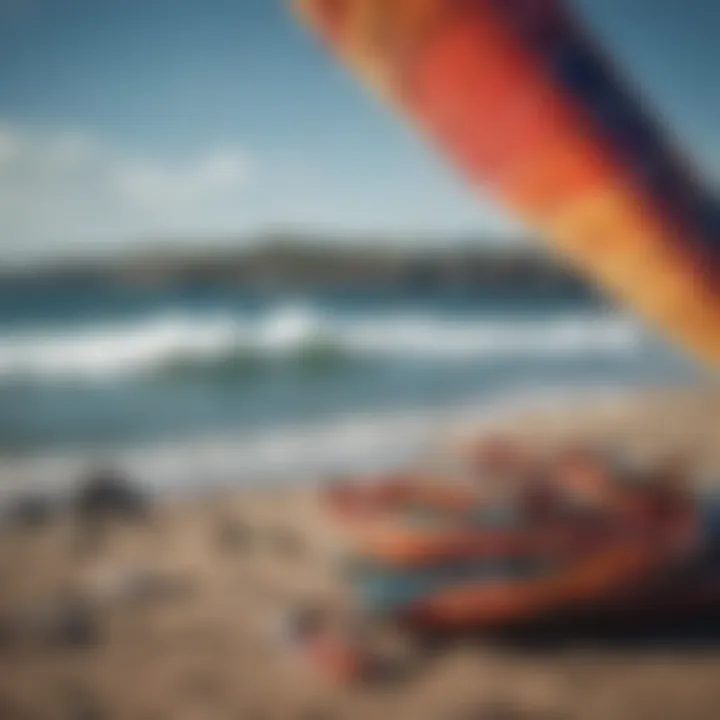
Ripstop Nylon
Ripstop nylon has become a staple in the world of kite building, beloved for its durability and lightweight nature. This fabric is made with a special reinforcing technique that prevents small tears from spreading, which is crucial during those turbulent flights.
The key selling point of ripstop nylon is its ability to fend off the elements, making it a beneficial choice for kites that will brave windy beach conditions. On the downside, ripstop nylon can be less resistant to UV rays over time, leading to possible fading. If you’re looking for affordable, reliable sail fabric, ripstop nylon is a solid choice.
Polyester
Another popular option is polyester, known for its excellent dimensional stability. Unlike many other fabrics, polyester won’t stretch or sag, ensuring your kite maintains its shape throughout its lifetime. It’s available in vibrant colors and has a lower price point compared to some more specialized materials.
While polyester is fairly resistant to UV rays, it doesn't quite match the tear resistance of ripstop nylon. So if you’re constructing a kite that you plan to fly frequently, consideration of where and how it will be used is essential.
Mylar
Mylar is a polyester film that has stolen the spotlight in the kite world due to its remarkable performance characteristics. Its lightweight yet sturdy nature makes it a high performer in terms of both speed and lift. When it comes to reflecting sunlight, mylar excels, giving your kite an eye-catching shine in the sky.
Although it’s a fantastic choice for enhancing a kite's aesthetic appeal and flight characteristics, mylar can be delicate. Handling this type of fabric requires care to avoid creasing or tearing, which could diminish its longevity. If you plan to personalize your kite with striking visuals, Mylar could certainly elevate your creation while keeping flight performance in check.
Strings and Connectors
Kite Lines
Kite lines are the unsung heroes of the kite-building process, essential for controlling the kite's movement in the air. These lines come in various materials, with some being more suitable for specific types of kites. High-tensile strength lines made from materials like Dacron are popular among serious kite surfers due to their durability and ability to withstand harsh conditions.
However, it's crucial to choose the right thickness and strength for your specific kite design. A too-thin line might fail when under heavy strain, while overly thick lines can create unwanted drag. Understanding your kite type can lead you to the appropriate line choice, maximizing flight enjoyment.
Bridles
Bridles are the silent engineers behind kite stability. They’re the lines that connect the sail to the frame, providing the necessary angles for optimal fly, and come in different setups based on kite designs. A well-designed bridle helps in achieving balanced flight, allowing for greater maneuverability as well.
One draw-back can be the complexity of constructing a bridle system, especially for novices. Yet, investing time in understanding and designing an effective bridle pays off with improved handling characteristics during flights, ultimately enhancing the overall riding experience.
Connectors
Connectors might seem like a minor detail, but they play a vital role in attaching the strings and bridle to your kite. The right connectors can secure various components together, offering both reliability and ease of assembly. Metal connectors tend to be favored for their robustness, ensuring that nothing comes unhooked at inopportune moments.
Plastic connectors, while lightweight, may not provide the same degree of reliability, especially during challenging conditions. A careful selection process here contributes to safety and performance, marking it as an essential consideration during the building process.
Remember, the materials you choose can make or break your kite-building project. Thoughtful selection leads to capable, high-flying kites that match the whims of the wind.
Step-by-Step Building Process
When embarking on the journey of kite building, the step-by-step process serves as the backbone of your creation. It not only helps to organize each phase of construction but also ensures that you don't accidentally miss any crucial elements that could affect the kite's performance. Every small decision you make along the way, from design to assembly, contributes to the end result. This clarity is vital for both novice builders and seasoned enthusiasts who may be venturing into new styles or materials.
Designing the Kite
Choosing Dimensions
Choosing the dimensions of your kite is a foundational step that sets the stage for everything that follows. The size determines how it will behave in the air, directly influencing its stability and maneuverability. Larger kites tend to catch more wind, making them a go-to for beginners who might appreciate the strength, while smaller kites can offer faster speeds and sharper turns for the more experienced.
Here's a nugget worth noting: dimension proportions can also affect how the kite handles wind. A wider span may be more suitable for leisure flights in lighter breezes, while a longer, narrower design can excel in swift winds. However, choosing dimensions involves trade-offs, and being too ambitious with size can lead to difficulties in launching or controlling the kite.
Sketching the Layout
Sketching the layout of your kite acts as the blueprint for your project. This is where imagination meets practicality. A clear sketch helps visualize the overall shape and elements you want to incorporate, which is essential when you start cutting materials. Having a picture to look at makes it easier to translate ideas into physical components.
The beauty of sketching is in its ability to allow for creativity while enabling calculated decisions about balance and design choices. A well-thought-out layout can also highlight potential pitfalls before you invest in materials, ultimately saving time and resources. If you haphazardly rush this step, you may find yourself with a kite that looks great on paper but fails in the sky.
Selecting Colors
Color selection might seem trivial at first glance, but it can transform a standard kite into a unique statement piece. The hues you choose can affect visibility and even performance, based on how they interact with sunlight and wind. Bright colors often help with visibility among other flyers and are easier to retrieve in case of a crash landing.
Additionally, experimenting with color can be an expression of individual style, making this decision highly personal. Yet, overdoing colors or patterns can create complications with sail tension, and using multiple layers might add unnecessary weight. Thus, it’s best to strike a balance between aesthetics and functionality.
Constructing the Frame
Cutting Materials
This phase is where precision becomes crucial. Cutting materials entails bringing your design to life and demands careful measurements to ensure that everything fits together seamlessly. The rigor in this step lays the groundwork for a more stable frame, which is paramount for the durability and flight capability of the kite.
Each blade cut is a choice that affects weight distribution. A clean, sharp cut not only looks professional but helps ensure that the rigging is straightforward when it comes time to assemble the skeleton. Conversely, jagged or incorrect cuts can lead to jagged edges that may snag during handling, potentially leading to injury or damage down the line.
Assembling the Skeleton
Assembling the skeleton of the kite resembles putting together a jigsaw puzzle. The framework gives shape and supports the sail, making it the heart of the structure. A focus on creating sturdy, precise connections will pay off in flight performance. Using appropriate connectors, such as knots or adhesive, plays a significant role in how well the kite maintains its shape during wind gusts.
Within this step, you might consider a mix of materials to enhance performance. For instance, pairing strong, flexible rods with lightweight connections could result in a kite that flexes rather than breaks under stress, ensuring longevity.
Reinforcing Joints
Reinforcing joints maximizes the durability of your kite’s frame, which is fundamental, especially for those venturing into turbulent conditions. Strengthening these points can prevent failures that lead to unwanted crashes, preserving your hard work.
Using tape or extra tubing to bolster these critical areas allows for better weight distribution and helps the kite withstand strong winds. It’s also a practical measure that doesn’t require complex materials or tools, making it achievable for builders at any skill level.
Attaching the Sail
Measuring and Cutting Fabric
Transitioning to the sail, measuring and cutting fabric is meticulous but vital. This sail acts as the main engine—providing lift and stability. An accurate cut ensures that the sail fits snugly without excess fabric that can flap during flight, diminishing control and performance.
Keeping in mind the aspect ratio can greatly affect how the kite flies. A well-measured sail provides better aerodynamics against the wind, leading to a smooth gliding experience.
Sewing Techniques
Now comes the sewing, which might sound straight from a craft fair, but it requires an understanding of fabrics and their properties. Using the right stitch not only secures edges but also influences how well the sail can hold up over time and during various weather conditions. Techniques like zigzag stitching add extra durability against tears, making it a favored method among kite flyers.
Perfecting this craft can mean the difference between a kite that stands the test of time and one that requires frequent repairs.
Securing the Edges
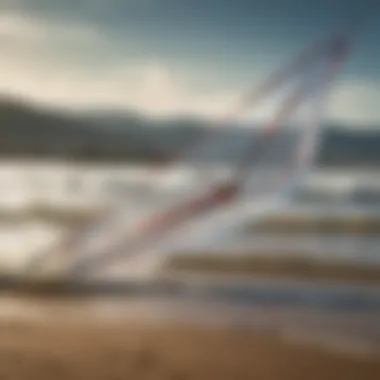
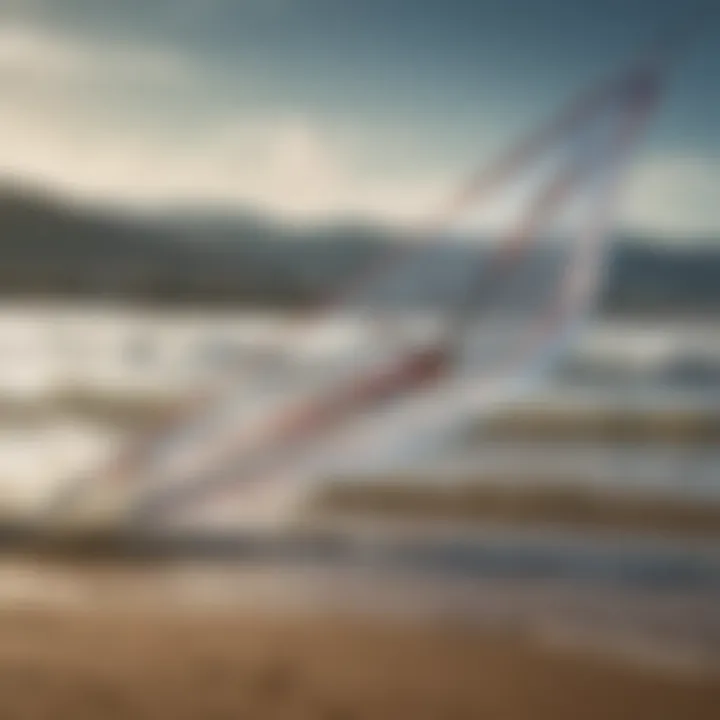
Securing the edges is the final touch that gives the kite its professional finish. Properly applied edge treatments prevent fraying and are particularly essential for longevity. Ignoring this step can lead to issues down the line, such as increased wear in high-stress areas.
Using techniques like folding and stitching or utilizing specialized edge tapes contributes to a robust wing capable of enduring numerous flights.
In summation, the step-by-step building process for kite construction, from design to sail attachment, encapsulates a comprehensive blend of artistic inspiration and technical acumen. Keeping a methodical approach will not only enable you to produce a kite that thrills in the air, but also instills the confidence needed for future projects.
Testing and Tuning the Kite
Testing and tuning the kite is an essential stage in the kite building process. This phase not only determines the functionality of your creation but also enhances your confidence as a builder. Getting the kite to truly fly as intended requires careful adjustments. It involves inspecting every component and testing how well they work together in the air. Think of it as fine-tuning a musical instrument, making sure that each part harmonizes with the others to produce an outstanding performance.
Pre-Flight Checks
Inspecting the Frame
Inspecting the frame is like checking the skeleton of a kite. The frame supports the entire structure, and any weakness or compromise here could result in a less than stellar flight. A sturdy frame provides the backbone necessary for maintaining the shape during flight, ensuring that the kite can withstand various wind conditions. The key characteristic of inspecting the frame is the thoroughness required. You want to look for anything that might have come loose during construction, signs of wear, or any fractured parts. A strong frame is a popular choice for kite builders due to its ability to handle stress without buckling. Besides, a well-constructed frame can greatly extend the lifespan of your kite.
Sail Condition
The sail condition is pivotal for ensuring that your kite flies efficiently. If the sail isn’t in tip-top shape, it won't catch the wind as designed, leading to poor performance. The important aspect of assessing your sail is to check for any tears, wrinkles, or wear spots that may affect lift and drag. A quality sail fabric, like ripstop nylon, is celebrated in this context for its durability and lightweight nature. Its unique feature is the extra threads woven into the fabric that help stop tears from spreading, thus maintaining the kite's performance. However, a sail that is too tight or too loose can also hinder flight, making proper inspection crucial.
String Integrity
String integrity can make or break a kite's flight. If the lines are frayed or weak, they can snap mid-fly, ruining your hard work in an instant. The characteristic that stands out when evaluating string integrity is the tactile sense; you need to feel for any rough spots or weaknesses in the line. Moreover, sturdy strings provide a safety net against unexpected stresses. Kite builders often prefer high-quality kite lines, such as those made from polyester or Kevlar, which are known for their resilience. The downside of weaker strings, on the other hand, is that they could lead to a crashing disappointment just when things were going smoothly.
Field Testing
Choosing the Right Location
Choosing the right location for field testing can be the difference between a successful flight and an unfortunate mishap. You want an area free of trees, power lines, and other obstacles. Open, flat spaces with ample room allow for ample testing and less likelihood of entanglement. The critical aspect here is wind consistency. An ideal spot will have reliable wind conditions that match the intended use of your kite. Locations like beaches or wide fields often become favorites among kite enthusiasts for their predictability. The unique feature of a well-chosen site is that you can use it repeatedly, giving you a familiar ground for future tests.
Wind Speed Considerations
Wind speed considerations are crucial while testing a kite. If the wind is too light, your kite won’t get off the ground. Conversely, too much wind can lead to uncontrolled flight, possibly damaging your kite and inciting safety issues. Understanding the ideal wind conditions for your specific kite type will guide the testing process. Checking wind speed before flight is beneficial, as it helps ensure safety. Wind speed that matches the design specifications can lead to thrilling, smooth flights. However, remember that windy conditions can vary, and being caught off guard can lead to misadventures.
Initial Flight Tests
Initial flight tests serve to breathe life into your creation. It’s the moment when your labor transforms from a set of materials into an airborne reality. The significant aspect of initial tests lies in observing how the kite performs in the air. Pay attention to any irregular movements. A successful flight requires a keen eye on stability and response. Test flights are popular among builders as it helps quickly identify any issues that may need addressing. However, don’t be discouraged if things don’t go as planned at first; testing is about making adjustments, learning, and improving.
Tuning for Performance
Adjusting Bridle Lengths
Adjusting bridle lengths can be paramount for optimizing kite performance. The bridle system acts as a connection point between the kite and the string, influencing how the kite flies. A well-tuned bridle allows for better lift and responsiveness. The crucial detail of adjusting bridle lengths is that small changes can significantly affect angle and stability. A popular approach is to experiment with different lengths during test flights. The unique aspect of bridle tuning is its ability to help achieve the best balance between lift and drag. But, be cautious; making radical changes can lead to the kite behaving unpredictably.
Balancing Weight Distribution
Balancing weight distribution is pivotal for smooth flight characteristics. If the kite is heavier on one side, it can malfunction or veer off course. The key characteristic to focus on is the distribution of materials you have used in the construction process. You may need to shift some materials or add small weight adjustments to specific parts of the frame or sail. The unique feature of proper weight distribution is its direct influence on maneuverability. While striving for balance may take some trial and error, getting this right is essential for achieving those perfect glides.
Tweaking Sail Tension
Tweaking sail tension is an art in itself. Tension impacts how the sail catches and holds wind. A sail that's too loose may flutter and fail to generate power, while one that's too tight can restrict airflow. Fine-tuning this aspect can lead to significant improvements in performance. The core aspect of sail tension is how it directly relates to the kite's responsiveness. Builders often prefer to experiment with different levels of tension based on the wind conditions. The unique feature of sail tensioning is the interplay it creates between lift and drag, urging you to constantly evolve your technique. If you find that the kite responds poorly during flight, revisiting the tension can often yield positive changes.
"Testing and tuning your kite might feel daunting but it's the gateway to elevated experiences in the air."
The process of testing and tuning not only teaches kite builders important lessons about their creations but also builds a deeper relationship with the art of kite making. Ensuring that every detail is in check, from pre-flight checks to fine-tuning performance factors, leads to kites that stand out in the sky.
Kite Maintenance and Repair
Maintaining and repairing your kite is crucial for ensuring it performs well and lasts through many flights. Just like any outdoor gear, kites are exposed to various elements that can wear them down, so regular attention to their condition is a smart move. This section looks at the best practices for maintenance and repair, emphasizing not just the longevity of the kite, but also enhancing your flying experience.
Regular Maintenance Tips
Cleaning the Kite
Cleaning a kite may sound trivial, but it’s one of the simplest yet most effective tasks to keep your gear in top shape. It helps to remove salt, sand, and dirt that may accumulate after a session at the beach or on a windy day.
A key characteristic of cleaning a kite is its role in preserving the fabric. Spraying it off with freshwater after a day of flying prevents the buildup of materials that can deteriorate the sail over time. This makes it a popular choice for kite enthusiasts looking to extend their kite’s lifespan without heavy investment. However: be careful with the fabric type; some materials might require specific cleaning methods to avoid damage.
Storing Safely
Where and how you store your kite can make a significant difference in its longevity. Ideal storage involves keeping the kite in a cool, dry place, away from direct sunlight. Before stowing it away, ensure it’s clean and completely dry to prevent mold and mildew from ruining its fabric.
The unique feature of safe storing is that it protects the kite against environmental factors which can cause material fatigue. For instance, folding the sail too tightly can create creases that might affect aerodynamics later on. Putting your kite in a bag also prevents abrasion with other gears.
Inspecting Materials Regularly
Regular inspection of your kite materials is an absolute must. This process includes checking the frame for cracks, ensuring that the sail is free from holes, and examining the lines for wear and tear.
What makes inspecting materials so beneficial is the ability to catch minor issues before they become major problems. For example, identifying frayed lines early on can save you a lot of headaches when you’re finally out on the water. In hindsight, neglecting this task might lead to unexpected failure mid-flight, which can spoil your enjoyment and even pose safety risks.
Common Repairs
Patching Fabric Tears
When it comes to repairing fabric tears, addressing them promptly can prevent larger damages that require a complete sail replacement. The method often involves using specialized patches and strong adhesives designed for kite fabric.
A prominent feature of patching fabric tears is its accessibility; most kite builders or surfers can perform it with relative ease. It’s a beneficial option as it allows you to continue enjoying your kite without a costly trip to a repair shop. On the downside, patching may not always be aesthetically pleasing, especially if not done meticulously.
Replacing Frayed Lines
Frayed lines can lead to a compromised flying experience. They not only affect the performance but can also lead to accidents if they break during use. Therefore, it’s vital to keep a spare set of lines on hand.
What stands out about replacing frayed lines is that it effectively ensures your kite remains reliable in the air. This repair option is considered a must for any serious kiter, as skipping this step can turn a fun afternoon into a frustrating one. However, some may find it challenging to choose the right line for their kite, as various types and materials exist.
Reinforcing Frame Weaknesses
Over time, frame components can become weak due to stress and strain, especially in high winds or trick-heavy sessions. Reinforcing these weaknesses is a proactive measure that involves using tape, adhesive, or even replacing parts of the frame with stronger materials.
The unique aspect of reinforcing frame weaknesses lies in its preventative nature. It can significantly extend the life of your kite and enhance its performance. However, the downside might involve some upfront costs or time, especially if you decide to upgrade to higher-quality materials.
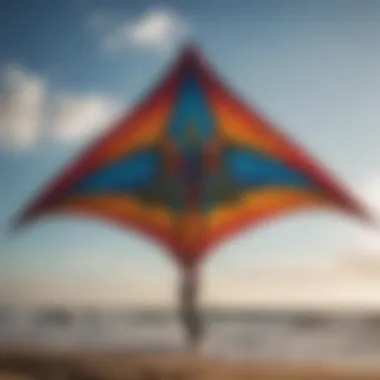

Exploring Advanced Techniques
As you delve deeper into kite building, exploring advanced techniques can markedly enhance the performance and aesthetic appeal of your kites. This section emphasizes the creative possibilities and material advancements available in kite design. Understanding these techniques opens up avenues for building kites that not only fly well but also stand out visually in the sky. Whether you want to challenge the air with bold designs or optimize performance through specialized materials, these elements can make a significant difference.
Custom Shapes and Designs
Innovative Shapes
When it comes to Innovative Shapes, the sky is literally the limit. Crafting kites in shapes that deviate from the traditional, like those resembling fantastical creatures or geometric wonders, can yield remarkable flight characteristics. The key characteristic here is aerodynamic efficiency. A well-thought-out innovative shape can allow for greater lift and stability, especially in varying wind conditions.
A unique feature of these shapes is their ability to interact with airflow in unexpected ways, enhancing performance during flight. However, one must consider the complexities in design—this can lead to increased difficulty in construction and potential lessons learned through trial and error. Nonetheless, if you seek to captivate crowds and create a spectacle in the air, innovative shapes undoubtedly stand out.
Pattern Variations
Pattern Variations involve manipulating the fabric and design patterns on your kite, impacting its visual appeal and individual identity. These variations can be as simple as stripes and polka dots or as intricate as custom artwork depicting local wildlife. The main takeaway is the focus on visual storytelling. Patterns can add layers of personality and flair while allowing builders to express themselves creatively.
These variations also serve a purpose beyond aesthetics; they can affect how light interacts with the sail. Certain colors and patterns can influence visibility in the sky, making it easier for you to maintain a watchful eye on your kite during gusty days. However, not every pattern will facilitate optimal performance; some may affect drag or stability, so a balance must be struck.
Personalization Options
Personalization Options are about tailoring your kite to reflect your own preferences and values. This can range from choosing colors and pattern designs to adding personal messages or decals. The key here is individual expression. Personalizing a kite can transform it into a unique piece reflecting a builder's spirit and passion, making flying not just an activity but a part of their identity.
A unique aspect of personalization is the emotional connection that develops; a kite that resonates personally will often enhance the overall experience on the water. On the downside, overly intricate personal designs might complicate the simplicity of performance-focused kites, which can be a trade-off to consider.
Advanced Materials
High-Performance Fabrics
High-Performance Fabrics are essential for those serious about kite building. Materials like ripstop nylon or specialized lightweight ripstop are leading choices. The standout characteristic of these fabrics is their durability combined with lightness. High-performance fabrics are designed to withstand rigorous conditions without added weight that could hinder flight.
One significant feature is their tear-resistant properties, meaning your kite can endure rough handling and still hold up over many flights. However, such materials can come at a premium in cost, and while the investment proves valuable in performance, it may deter some novice builders from venturing into high-end options.
Lightweight Frames
Lightweight Frames contribute significantly to the overall performance of kites, specifically regarding how well they handle in the air. Constructing your kite’s frame with materials such as carbon fiber or aluminum ensures that your design remains agile and responsive. The main benefit here is agility—lightweight frames adapt quickly to shifts in wind, allowing for a more dynamic flying experience.
One might observe that lightweight does not always mean fragile; modern engineering techniques have delivered strength without compromising weight. However, such frames require careful handling and could be less forgiving in rough landings compared to sturdier options.
Specialty Coatings
Among Specialty Coatings, the use of polyurethane or silicone can greatly enhance a kite’s performance. Coatings act as a barrier against moisture and UV rays, increasing the overall lifespan of your kite. These coatings are imperative for extended use, especially in marine settings where saltwater exposure can lead to rapid degradation.
The unique feature of these coatings lies in their waterproofing properties. While they may add a minor layer of weight to the fabric, the benefits of protecting your investment from the elements far outweigh any disadvantages. In essence, specialty coatings help in maintaining kite integrity, ensuring your investment pays dividends over time whether on or off the water.
Community and Resources
The kite building community is a treasure trove of information and support. Engaging with others who share your passion can significantly enhance both your practical skills and understanding of kites. This section zeroes in on the various channels through which kite enthusiasts can connect, learn, and share their creations.
Joining Kite Building Communities
Online Forums
Online forums act as digital gathering places for kite builders around the world. These platforms, such as those found on reddit.com, allow for real-time discussions about techniques, materials, and even troubleshooting issues that arise during the building process. A key characteristic of online forums is their diverse membership, drawing experts and novices alike who are eager to share insights.
The collaborative nature of these spaces makes them a beneficial choice for aspiring builders. You can ask questions, share experiences, and even seek feedback on your designs. The unique feature of online forums is their ability to provide a wealth of resources at the click of a button—images and sketches can be shared easily, enhancing understanding. However, it's worth noting that the quality of advice can vary, as not all participants may have the same level of expertise.
Local Clubs
Local kite clubs offer a tangible way to engage with fellow kite enthusiasts. These clubs provide opportunities for networking and face-to-face interaction, enriching the learning experience. The camaraderie found in local clubs fosters community spirit and turning mere acquaintances into friends. One striking feature of local clubs is the organization of regular meet-ups, where builders can show off their creations and fly together, making for a lively atmosphere.
As an advantage, these clubs often have access to shared resources, such as tools and materials, that can be expensive to purchase individually. However, if there’s a downside, it might be the time commitment to attend meetings and events.
Workshops and Events
Workshops and events are another rewarding avenue to dive deeper into kite building. These organized sessions usually focus on specific skills or topics, offering hands-on experience with guidance from seasoned experts. A major benefit here is the structured environment, which can accelerate your learning process. Unique to workshops is the opportunity for immediate feedback as you build under the watchful eye of instructors.
Events like kite festivals not only bring enthusiasts together but also serve as a platform to display your skills and learn from others. However, some may find that the cost of attending workshops can add up. In contrast, the knowledge gained and the connections made can often outweigh the financial investment.
Further Reading and Learning
To deepen your understanding and enhance your kite building skills, exploring additional literature and video resources can be incredibly fruitful. This section outlines various resources that can serve as valuable companions on your kite building journey.
Books on Kite Design
Books on kite design offer a wealth of information, from basic principles to advanced design techniques. These texts often feature detailed illustrations and diagrams, helping readers visualize complex concepts. A significant characteristic is their depth; many books include historical context, allowing builders to appreciate the evolution of kite design. Books are a popular choice for those who prefer a structured and comprehensive approach to learning.
However, the downside can be the difficulty in finding specific, niche books that cater to personal interests. Additionally, they reflect the knowledge at the time of their writing, which could become outdated with rapid advancements in kite technology.
Video Tutorials
Video tutorials bring a dynamic visual element to the learning process. These resources can show step-by-step instructions that books struggle to convey. With platforms like YouTube, you can access content created by experts and hobbyists alike. A notable advantage is that viewers can pause, rewind, and replay sections to grasp difficult concepts.
Nevertheless, the sheer volume of content available can be overwhelming, making it hard to find quality tutorials. Some may also find that visual formats lack the depth of printed materials, as they tend to focus more on practical execution than underlying theory.
Expert Blogs
Expert blogs can be a goldmine for up-to-date techniques and trends in kite building. They provide insights from experienced builders who share their personal stories, tips, and breakthroughs. A key feature of these blogs is their conversational tone, making complex topics more relatable and easier to understand.
The accessibility of blog posts allows for a quick read, perfect for those with busy schedules. However, as with online forums, the quality can be inconsistent; not every blog is created equally. It’s important to seek out individuals who have credible experience in kite building.
In summary, the kite building community is not just a collection of resources but a supportive space where knowledge flourishes. Whether through forums, clubs, workshops, or literature, the connections and learning opportunities await those willing to dive in.
Culmination
As we wrap up this comprehensive exploration of kite building, it’s crucial to reflect on the significance of this art form. Kite construction is not just about putting materials together; it is a blend of creativity, science, and craftsmanship that fosters a deeper appreciation for the sport of kitesurfing and aerial adventures. The journey from conceptualization to flight teaches patience, problem-solving, and the joy of seeing one’s ideas take to the skies.
Recap of Key Points
Throughout this guide, we covered a variety of essential elements that come into play in kite building. Here’s a quick refresher on the pivotal points:
- Understanding Kite Design: Knowing the different types of kites, like stunt and box kites, is foundational to making the right choices for your crafting endeavors.
- Materials Needed: The selection of proper materials, from frame materials like carbon fiber to fabrics such as ripstop nylon, can significantly affect performance and durability.
- Step-by-Step Building Process: Following a structured approach ensures consistency and quality, with steps ranging from designing the kite to attaching the sail securely.
- Testing and Tuning the Kite: No kite flies perfectly on the first try. Conducting thorough pre-flight checks and field tests is essential to optimize kite performance.
- Kite Maintenance and Repair: Understanding how to maintain and repair your kite lets you extend its life and enjoy it longer.
- Exploring Advanced Techniques: Once you’re comfortable with the basics, experimenting with custom shapes and advanced materials can take your kite building to new heights.
- Community and Resources: Connecting with fellow kite enthusiasts in online forums or local clubs opens up opportunities for shared learning and collaboration.
Encouragement for New Builders
To those considering embarking on their kite building journey, remember that like any skill, mastery comes with time and practice. Don't be discouraged if your first few kites don't soar like the majestic creations you envision. Instead, view each attempt as a valuable lesson. The beauty of kite building lies not just in the finished product, but in the knowledge gained and the passion ignited along the way. As you layer fabric, choose colors, and tune your bridle, you’re not just crafting a kite but also building memories that will accompany you on the waves.
Whether you aim to entertain family, impress friends or even enhance your kitesurfing experience, let your creativity fly. Dive into the craft, learn from the community, and most importantly, have fun watching your efforts catch the wind!



